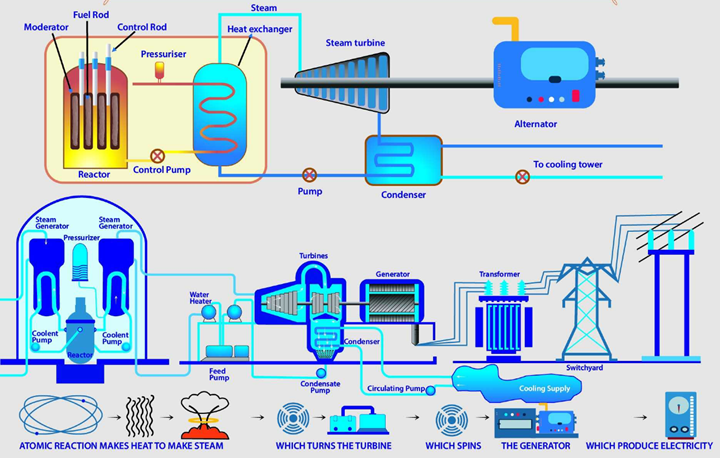Nuclear Power
-
THE NUCLEAR REACTOR
A nuclear reactor is a device used to initiate and control a self-sustained nuclear chain reaction. In a nuclear power reactor, the energy released is used as heat to make steam to generate electricity.
The principles for using nuclear power to produce electricity are the same for most types of reactors. The energy released from continuous fission of the atoms of the fuel is harnessed as heat in the form of either gas or water. The heat is then used to produce steam that drives the turbines which produce electricity.
The main design is the pressurized water reactor (PWR) which has water at over 300oC under pressure in its primary cooling/heat transfer circuit and generates steam in a secondary circuit.
The less numerous boiling water reactor (BWR) makes steam in the primary circuit above the reactor core, at similar temperatures and pressure. Both types use water as both coolant and moderator to slow neutrons. Since water normally boils at 100oC, they have robust steel pressure vessels or tubes to enable the higher operating temperature.
COMPONENTS OF A NUCLEAR REACTOR
There are several components common to most types of reactors:

· Fuel
Uranium is the basic fuel. Usually pellets of uranium oxide (UO2) are arranged in tubes to form fuel rods. The rods are arranged into fuel assemblies in the reactor core. In 1000MWe class PWR there might be 5,100 fuel rods with over 18 million pellets
· Moderator
A moderator increases the power of the reactor by causing the fast neutrons that are released from fission to lose energy and become thermal neutrons. Thermal neutrons are more likely than fast neutrons to cause fission. Moderator is usually water but may be heavy water or graphite.
· Control Rods
These are made with neuron-absorbing material such as cadmium, hafnium or boron, and are inserted or withdrawn from the core to control the rate of reaction, or to halt it. In some PWR reactors, pedal control rods are used to enable the core to sustain a low level of power efficiently.
· Coolant
Coolant is the fluid that circulates through the core so as to transfer heat from it. In light water reactors the water moderator functions also as a primary coolant. A PWR has two to four primary coolant loops with pumps driven either by steam or electricity.
· Pressure Vessel or Pressure Tubes
It’s usually a robust steel vessel constraining the reactor core and moderator/coolant.
· Steam generator
It is part of the cooling system of pressurized water reactors where the high-pressure primary coolant bringing heat from the reactor is used to make steam for the turbine in a secondary circuit.
· Containment
It is the structure around the reactor and associated steam generators, designed to protect them from outside intrusion and to protect the outside from the effects of radiation in case of any serious malfunction inside. It is typically a meter-thick concrete and steel structure.

THE POWER RATING OF A NUCLEAR POWER REACTOR
Nuclear plant reactor power outputs are quoted in three ways:
· Thermal MWt, which depends on the design of the actual nuclear reactor itself and relates to the quantity and quality of the steam it produces.
· Gross electrical MWe indicates the power produced by the attached steam turbine and generator, and also takes into account the ambient temperature of the condenser circuit (cooler means more electric power, warmer means less).
· Net electrical MWe, which is the power available to be sent out from the plant to the grid, after deducting the electrical power needed to run the reactor (cooling and feed-water pumps, etc.) and the rest of the plant.
